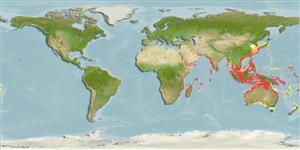Environment: milieu / climate zone / depth range / distribution range
Écologie
marin récifal; profondeur 2 - 128 m (Ref. 58479), usually 15 - 30 m (Ref. 90102). Tropical; 42°N - 38°S, 29°E - 174°W
Indo-West Pacific: Red Sea and Persian Gulf south to Mozambique and east to the western Pacific where it ranges from Japan to Sydney (Ref. 11411). Recorded from the Eastern Mediterranean (Ref. 93672).
Taille / Poids / Âge
Maturity: Lm ? range ? - ? cm
Max length : 12.6 cm TL mâle / non sexé; (Ref. 111101); common length : 7.0 cm SL mâle / non sexé; (Ref. 37816)
Épines dorsales (Total): 8; Rayons mous dorsaux (Total): 9; Épines anales 2; Rayons mous anaux: 8. Characterized by having generally white to dusky pinkish body color; 3-4 dark stripes on upper half of body; presence of broad, uniform midlateral stripe continued to caudal fin; narrower stripe above eye to upper caudal peduncle; base of dorsal fin to upper caudal peduncle with thin stripe; incomplete diffuse stripe above midlateral strip; greatest depth of body 2.6-2.7 in SL (Ref. 90102).
Inhabits coastal reefs, in sandy or weedy areas (Ref. 9710). Nocturnal. Juveniles often occur with sea anemones (Ref. 37816).
Life cycle and mating behavior
Maturité | Reproduction | Frai | Œufs | Fécondité | Larves
Mouthbrooders (Ref. 240). Distinct pairing during courtship and spawning (Ref. 205).
Paxton, J.R., D.F. Hoese, G.R. Allen and J.E. Hanley, 1989. Pisces. Petromyzontidae to Carangidae. Zoological Catalogue of Australia, Vol. 7. Australian Government Publishing Service, Canberra, 665 p. (Ref. 7300)
Statut dans la liste rouge de l'IUCN (Ref. 130435)
Menace pour l'homme
Harmless
Utilisations par l'homme
Pêcheries: sans intérêt
Plus d'informations
RéférencesAquacultureProfil d'aquacultureSouchesGénétiqueElectrophoresesHéritabilitéPathologiesTraitementNutrientsMass conversion
Outils
Articles particuliers
Télécharger en XML
Sources Internet
Estimates based on models
Preferred temperature (Ref.
123201): 24.6 - 29, mean 28.1 °C (based on 826 cells).
Phylogenetic diversity index (Ref.
82804): PD
50 = 0.5000 [Uniqueness, from 0.5 = low to 2.0 = high].
Bayesian length-weight: a=0.01230 (0.00663 - 0.02283), b=3.09 (2.93 - 3.25), in cm total length, based on LWR estimates for this species & Genus-body shape (Ref.
93245).
Niveau trophique (Ref.
69278): 3.6 ±0.5 se; based on diet studies.
Résilience (Ref.
120179): Haut, temps minimum de doublement de population inférieur à 15 mois (Preliminary K or Fecundity.).
Fishing Vulnerability (Ref.
59153): Low vulnerability (10 of 100).
Nutrients (Ref.
124155): Calcium = 108 [55, 177] mg/100g; Iron = 0.852 [0.491, 1.468] mg/100g; Protein = 18.6 [17.4, 19.8] %; Omega3 = 0.147 [0.084, 0.253] g/100g; Selenium = 40.6 [21.3, 77.1] μg/100g; VitaminA = 57.3 [16.3, 203.8] μg/100g; Zinc = 1.42 [0.94, 2.06] mg/100g (wet weight);
